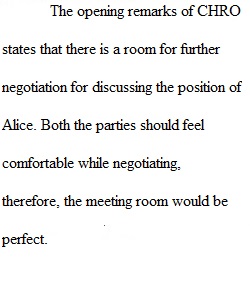


Q III. PIOC Analysis Overview A. Formulate appropriate phrasing for the CHRO’s opening remarks that separate the people from the problems. Your phrasing must be based on principled negotiation practices. B. Identify case-specific negotiating positions and rephrase them as interests. In other words, Sharon Slade and Alice Jones’ ZOPA and BATNA positions should be referred to as case-specific negotiating interests. For example, one of Alice Jones’ possible ZOPA positions may be to obtain a 52-week severance package, during which her compensation and benefits continue through the severance period. This can be rephrased as an interest by adding Alice Jones’ rationale for this position: 52 weeks of severance allows for adequate time to find a comparable position as well as time for her family to relocate to a new geographic region. You have the option of using a table to illustrate each position and the appropriate rephrased interest (one row per position-interest). C. Recommend options that can appropriately address the parties’ integrative interests. You will want to use the open, closed, alternative, and leading questions developed in the Module Five assignment to craft an integrative bargaining proposal. Feel free to consider potential creative options that may not be as common. D. Identify objective criteria that can be used to measure distributive elements of the negotiation. Explain the reasoning for your choices. IV. Communication Strategies A. Identify examples of effective overt communication that could be used in this negotiation. Explain the reasoning for your choices. For example, when hearing a proposal from the executive that would be risky from a human resources perspective, how would you respond? Why? B. Identify situations where tacit communication is important to this negotiation. Provide examples of how you might use such communication at upcoming meetings. For example, if you are making an offer to the executive, what non-verbal cues can you provide to let him/her know the offer is final and you would not be open to negotiating further? C. Contrast the benefits and risks of using overt and tacit communication methods with respect to this negotiation. For example, might one particular method be more appropriate than the other? Why?
View Related Questions